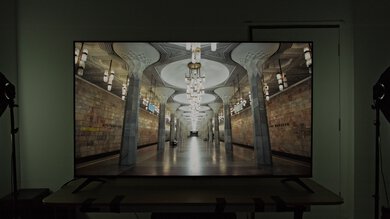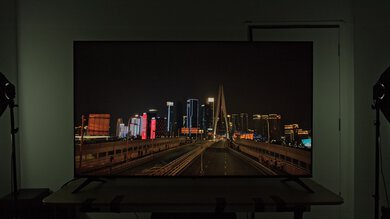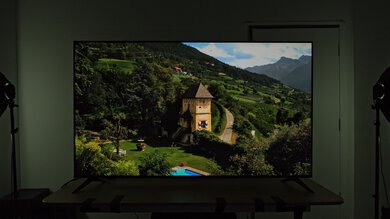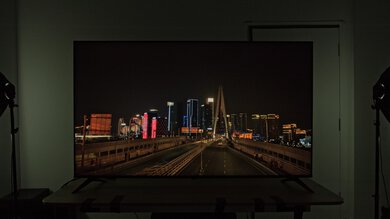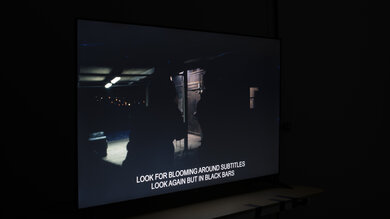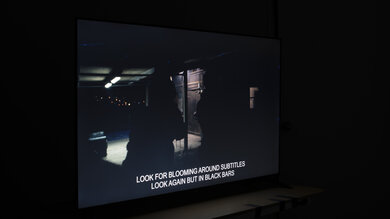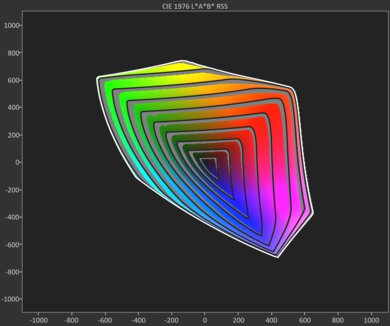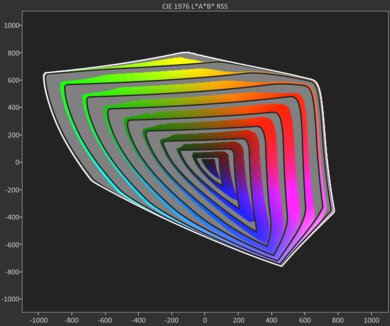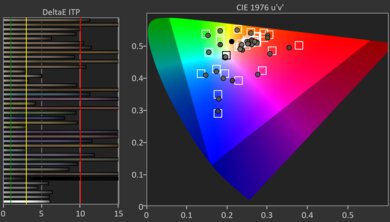The LG UT7570 is an entry-level TV released in 2024. It's a 60Hz option and doesn't have modern features like local dimming, VRR support, or HDMI 2.1 bandwidth, but it still has some basic features like motion interpolation and Auto Low Latency Mode for gaming. It's powered by LG's α5 AI Processor Gen 7, which is designed to deliver refined picture and audio quality. The TV runs version 24 of LG's webOS and has a built-in 20W 2.0 channel speaker system that can be up-mixed to virtual 5.1 surround sound. We bought and tested the 65-inch model, but it's available in seven sizes total: 43, 50, 55, 65, 70, 75, and 86 inches.
Our Verdict
The LG UT75 is bad for mixed usage. Its reflection handling leaves a lot to be desired, and it's a very dim TV, so it's not good for use in a bright room or for HDR content. Unfortunately, it doesn't look good in a dark room either due to its awful black levels and muted colors. The TV doesn't have any modern gaming features, and its slow pixel transitions means motion is blurry, so it's not a good gaming TV either. You do get adequate image processing that helps clean up low-quality content, and it does have a wide viewing angle, but those features only go so far on a TV like this one that has poor image quality to begin with.
-
Wide viewing angle means it's suitable for use in a group setting.
-
Poor black uniformity, awful contrast, and no local dimming means blacks look gray.
-
Not bright enough in SDR to overcome glare.
-
Poor HDR brightness leads to a bad HDR experience.
-
Slow smart interface.
-
Colors are muted and dim.
The LG UT75 is bad for a home theater. It has awful black levels, so blacks look gray at all times. The TV only displays a narrow range of dim colors, which leads to colors that lack vibrancy, and there's noticeable banding in color gradients. Furthermore, HDR content lacks impact since the TV is too dim. Fortunately, it has okay upscaling and good low-quality content smoothing, so DVDs and low-quality streams look alright. Additionally, there's not very much stutter, so motion in movies and TV shows is mostly smooth. However, it doesn't remove judder from 60Hz sources.
-
Very little stutter due to its slow response time.
-
Good low-quality content smoothing.
-
Poor black uniformity, awful contrast, and no local dimming means blacks look gray.
-
Poor HDR brightness leads to a bad HDR experience.
-
Slow smart interface.
-
Colors are muted and dim.
-
Doesn't remove judder from 60Hz sources.
The LG UT75 is poor for use in a bright room. It doesn't have the reflection handling or brightness needed to fight glare, so reflections on the screen are very distracting. Ambient light doesn't affect colors very much, but since the TV has poor colors to begin with, colors are muted. Black levels also aren't affected by the lights in your room, but since the TV has such bad blacks to start with, they still look gray.
-
Not bright enough in SDR to overcome glare.
-
Colors are muted and dim.
-
Bad handling of direct reflections.
The LG UT75 is disappointing for watching sports. Colors aren't very accurate, and they really lack vibrancy, so the entire image looks muted. You're easily distracted by reflections on the screen since the TV is too dim and doesn't have the reflection handling needed to handle glare in a room with open curtains or even a few lights on. It does a good job reducing artifacts in low-quality broadcasts, and its upscaling is good enough that the image doesn't look too soft. Fortunately, the TV does have a wide viewing angle, which is useful for watching the game with a group since the image doesn't drastically degrade when viewed from the sides of the screen.
-
Wide viewing angle means it's suitable for use in a group setting.
-
Good low-quality content smoothing.
-
Not bright enough in SDR to overcome glare.
-
Slow smart interface.
-
Colors are muted and dim.
-
Very slow pixel transitions leads to blurry motion.
-
Bad handling of direct reflections.
The LG UT75 is bad for gaming. It's limited to 60Hz, and it doesn't support VRR to reduce screen tearing, so it's not a good option if you care about high frame rates and modern gaming features. It has low input lag for a responsive feel, but pixel transitions are unusually slow, so motion is blurry. Colors look muted in your favorite games due to the TV's inadequate color volume in SDR and HDR, and the TV is too dim to display highlights in HDR games with any impact. Unfortunately, the TV's black levels are awful, so the entire image looks washed out whether or not you're using the Game Optimizer.
-
Low input lag.
-
Poor black uniformity, awful contrast, and no local dimming means blacks look gray.
-
Poor HDR brightness leads to a bad HDR experience.
-
Limited to 60Hz refresh rate and no modern gaming features.
-
Colors are muted and dim.
-
Very slow pixel transitions leads to blurry motion.
The LG UT75 has bad brightness. It's too dim in SDR to use in a room with more than one or two lights on, and its HDR brightness isn't nearly good enough to display meaningful highlights in HDR content.
-
Not bright enough in SDR to overcome glare.
-
Poor HDR brightness leads to a bad HDR experience.
The LG UT75 has awful black levels. The TV doesn't have local dimming, and it has terrible native contrast with poor black uniformity, so blacks look blueish and cloudy at all times.
-
Poor black uniformity, awful contrast, and no local dimming means blacks look gray.
The LG UT75 has disappointing colors overall. It doesn't display a wide range of colors, and it lacks the brightness to show colors with any vibrancy, leading to muted colors. Color accuracy is passable in both SDR and HDR, but don't expect precise colors with this model.
-
Colors are muted and dim.
Note: We're in the process of improving our tests related to image processing, but this score should give you a general idea of how a TV performs overall with its image processing capabilities.
The LG UT75 has adequate image processing overall. HDR content has okay brightness accuracy overall, but shadows and darker midtones are too bright. There's also some noticeable banding in color gradients. The TV's upscaling is good enough that the image doesn't look overly soft, and it does a good job minimizing artifacts in low-quality content.
-
Good low-quality content smoothing.
The LG UT75 has poor responsiveness in Game Mode. It doesn't support VRR, so you do see screen-tearing. Although the TV's input lag is low enough for a responsive feel, the TV's pixel transitions are so slow across the board that motion looks very blurry.
-
Low input lag.
-
Limited to 60Hz refresh rate and no modern gaming features.
-
Very slow pixel transitions leads to blurry motion.
We're in the process of fixing the way we evaluate a TV's overall motion handling. This section is currently broken, and the score isn't indicative of how well a TV handles motion overall.
- 4.6 Mixed Usage
- 4.3 Home Theater
- 5.1 Bright Room
- 5.7 Sports
- 4.3 Gaming
Performance Usages
- 4.2 Brightness
- 2.1 Black Level
- 5.3 Color
- 6.9 Processing (In Development)
- 5.0 Game Mode Responsiveness
- 7.3 Motion Handling (Broken)
Changelog
- Updated May 08, 2025: Converted to Test Bench 2.0.1. We did this to fix an issue with our scoring in the Supported Resolutions section, since TVs with a refresh rate higher than 144Hz were being penalized for not supporting 144Hz.
-
Updated Mar 26, 2025:
We wrote text for the new tests and rewrote text throughout the review after updating pre-existing tests and scores for Test Bench 2.0.
- Updated Mar 26, 2025: We converted the review to Test Bench 2.0. With this new methodology, we've added new tests to expand the scope of our testing, adjusted our scoring to better align with current market conditions, and added performance usages that group related tests together to give more insight into specific aspects of a TV's performance. You can find a full list of changes in the TV 2.0 changelog.
-
Updated Nov 07, 2024:
Mentioned the newly-reviewed Samsung DU7200/DU7200D in the SDR Brightness section.
-
Updated Oct 23, 2024:
We bought and tested the LG UT8000, and added a mention of it in the Contrast section of the review.
Check Price
Differences Between Sizes And Variants
We bought and tested the 65-inch LG UT75, and most of our results are also valid for the 43, 50, 55, 70, 75, and 86-inch models. The 43, 70, 75, and 86-inch models are sold as the LG UT7590PUA, and they use different feet and have a different back design with the inputs on the left side of the TV.
| Size | US Model |
|---|---|
| 43" | 43UT7590PUA |
| 50" | 50UT7570PUB |
| 55" | 55UT7570PUB |
| 65" | 65UT7570PUB |
| 70" | 70UT7590PUA |
| 75" | 75UT7590PUA |
| 86" | 86UT7590PUA |
Our unit was manufactured in April 2024, as seen on the label.
Popular TVs Comparisons
You shouldn't buy the LG UT75, as it's a bad TV with no modern features and poor picture quality. It's held back by its awful contrast that can't be improved due to a lack of a local dimming feature, so it doesn't look very good in a dark room. It's also a dim TV overall that's not bright enough for use in a well-lit room or to provide an impactful HDR experience. If you're looking for a budget-friendly TV, you would be much better off getting a TV like the Hisense U6/U6N, as that TV has a great local dimming feature that delivers significantly deeper blacks, a wide color gamut for more vibrant colors, and it's brighter overall.
See our recommendations for the best budget TVs, the best TVs under $500, and the best 65-inch TVs.
The Samsung DU7200 is better than the LG UT75. The Samsung displays deeper blacks in a dark room, and it overcomes more glare in rooms with the lights on due to its better SDR brightness. The Samsung also displays slightly more vibrant colors, does a better job at upscaling, and has a quicker response time for less blur behind fast motion. However, the LG does a much better job removing artifacts from low-quality content, and it has a significantly wider viewing angle.
The LG UT75 and the LG UT8000 are similar overall, but the UT80 is a bit better for most people. The UT80 has a much higher contrast ratio, so it's a better choice for dim or dark rooms, as blacks are deeper and more uniform. On the other hand, if you never watch TV in a dark room, the UT75 might be a better choice as it has a wider viewing angle, so you'll see a more consistent image if you're watching at a bit of an angle.
The LG UT75 is a bit better than the LG UQ75. The UT75 is a bit brighter overall and has slightly better reflection handling, so it fights a bit more glare in a room with some lights on, but it’s still too dim for use in a well-lit room. The biggest advantage that the UT75 has is its quicker response time, which delivers fast motion with less blur. The UT75 also has better PQ EOTF tracking, so it sticks closer to the content creator’s intent with HDR content. Outside of that, the two TVs are essentially the same.
The Samsung DU6900 is better than the LG UT75. The Samsung is a bit brighter in HDR and SDR, handles reflections better, has much deeper contrast, is more colorful, and has better PQ EOTF tracking than the LG. The LG is more accurate in SDR out of the box and has a much wider viewing angle. Still, the Samsung TV is the better choice unless you're shopping for a cheap TV to host large parties.
The Samsung DU8000 is better than the LG UT75 in most ways. The Samsung supports a wide color gamut, so it displays more vibrant and lifelike colors, and its much better contrast ratio and black uniformity means it delivers deeper blacks in a dark room. The Samsung also has a slightly faster response time for less blur behind quick motion. However, the LG has a much wider viewing angle, so it's the better option if you regularly watch TV with a group. The LG also has better low-quality content smoothing, so it does a better job at removing artifacts from low-bitrate content.
The Hisense U6N is much better than the LG UT75. The Hisense is much brighter overall, so it overcomes a lot more glare in a bright room and displays brighter highlights in HDR content. The Hisense has a massive advantage when it comes to contrast since it has an effective local dimming feature that delivers much deeper blacks in a dark room. The Hisense also has a wide color gamut, so it displays more vibrant and lifelike colors. Finally, the Hisense is better for gamers due to its faster response time and the ability to game in up to 1440p @ 120Hz.
The Samsung Q60D is better than the LG UT75. The Samsung has better contrast and much better black uniformity, so it delivers deeper blacks in a dark room. When it comes to color vibrancy, the Samsung is the better TV due to its wide color gamut and better color volume. The Samsung is also the brighter TV overall, so it fights more glare in a well-lit room and provides a more impactful HDR experience.
The Samsung Q60C and the LG UT75 are better than each other in different ways. The Samsung is the much brighter TV in SDR, meaning it overcomes more glare in a well-lit room. The Samsung supports a wide color gamut, so it delivers more vibrant and lifelike colors. The Samsung also has better contrast and black uniformity for deeper blacks in a dark room. On the other hand, the LG has a faster response time for less blur behind fast motion, and its wider viewing angle makes it the better option for use in a group setting.
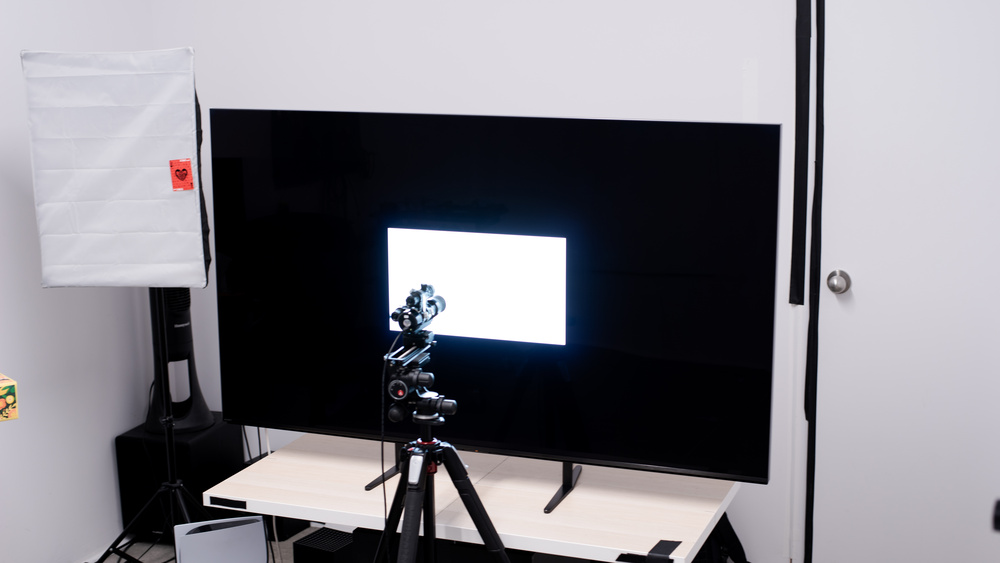
We buy and test dozens of TVs yearly, taking an objective, data-driven approach to deliver results you can trust. Our testing process is complex, with hundreds of individual tests that take over a week to complete. Most of our tests are done with specially designed test patterns that mimic real content, but we also use the same sources you have at home to ensure our results match the real-world experience. We use two main tools for our testing: a Colorimetry Research CR-100 colorimeter and a CR-250 spectroradiometer.
Test Results
The LG UT75 has poor HDR brightness. It's not bright enough to display HDR content properly. Bright highlights don't stand out at all, and overall, this TV doesn't provide an impactful HDR experience.
These measurements are after calibrating the HDR white point, with the following settings:
- HDR Picture Mode: Cinema
- Panel Brightness: 100
- Contrast: 100
- Color: 50
- Color Temperature: Warm 50
- Dynamic Tone Mapping: Off
Although the TV is slightly dimmer in Game Optimizer, it's not noticeable.
These measurements are after calibrating the HDR white point with the following settings:
- HDR Picture Mode: Game Optimizer
- Panel Brightness: 100
- Contrast: 100
- Color: 50
- Color Temperature: Warm 50
- Dynamic Tone Mapping: HGiG
The TV has bad SDR brightness. It's not bright enough to overcome glare in a well-lit room, so it's best suited for dark or dimly lit rooms.
These measurements are after calibration with the following settings:
- Picture Mode: Dark Space, night
- Brightness: 100
- Color Temperature: Warm 50
- Gamma: 2.2
If you need a similarly priced TV with better SDR brightness, consider the Samsung DU7200/DU7200D.
The LG UT75 has awful contrast. Blacks are raised and look gray most of the time, and the TV lacks a local dimming feature to improve its contrast. The step-up model to this one, the LG UT8000, has much better contrast but still lacks a local dimming feature.
This TV doesn't have a local dimming feature, so it can't adjust the backlight of individual zones to brighten up highlights without impacting the rest of the image. This means that there are no distracting flickers or brightness changes as bright highlights move across the screen.
The LG UT75 has poor SDR color volume. It lacks the color volume in DCI-P3 to fully display dark colors, and the TV doesn’t come close to showing light colors as well as it does pure white. This is even more pronounced in the wider BT.2020 color space, where its coverage is less than half overall.
| Volume ΔE³ | DCI-P3 Coverage | BT.2020 Coverage |
|---|---|---|
| L10 | 64.25% | 42.81% |
| L20 | 72.75% | 49.31% |
| L30 | 75.07% | 51.46% |
| L40 | 74.97% | 52.53% |
| L50 | 73.66% | 52.40% |
| L60 | 70.57% | 50.08% |
| L70 | 66.09% | 42.61% |
| L80 | 65.08% | 40.13% |
| L90 | 65.15% | 40.02% |
| L100 | 75.66% | 49.83% |
| Total | 69.84% | 46.60% |
The TV's HDR color volume is bad. It does a poor job at displaying dark colors due to its awful contrast, and the TV isn't nearly bright enough to display colors at high luminance levels.
The TV has just alright pre-calibration SDR accuracy. Reds and greens are overrepresented in dark shades of gray, and blues are overrepresented in most shades of gray. The color temperature is much cooler than our target of 6500K, so the image is too blue. Gamma is close to our target of 2.2, but dark scenes are much brighter than intended, and moderately lit scenes are a bit too dark. Fortunately, the TV has very good color accuracy in SDR, but whites and lighter shades of most colors are inaccurate.
The TV has outstanding accuracy after calibration. The white balance is much better now, with only reds, greens, and blues overrepresented in dark shades of gray. The color temperature is now essentially perfect, and gamma is a bit closer to our target of 2.2, although dark scenes are still too bright. Color accuracy is even better, but there are some minor inaccuracies with blues.
See our full calibration settings.
The LG UT75 has mediocre HDR accuracy before calibration. Blues are very overrepresented in all shades of gray, which makes the TV's color temperature significantly cooler than 6500K. It has decent color accuracy overall, but there are numerous inaccuracies in most colors.
The TV has great HDR accuracy after calibration. There's still a bit too much blue in darker shades of gray, and not enough blue in some mid-grays. However, its color temperature is much closer to 6500K and no longer looks too cool. Color accuracy is much better now, but there are still some minor inaccuracies across its range of colors.
The TV has okay PQ EOTF tracking. Blacks and near-blacks are noticeably raised, but the TV follows the curve very closely until it approaches its peak brightness. With content mastered at 600 and 1000 nits, there's a gradual roll-off near the TV's peak brightness to retain detail in highlights. With content mastered at 4000 nits, the roll-off is much more gradual.
The TV does an okay job at upscaling low-resolution content like DVDs or lower-resolution streams. Details aren't overly soft, but finer details are very hard to make out.
Sharpness processing was calibrated with no over-sharpening for low-resolution content, with the following settings:
- Sharpness: 17
- Super Resolution: High
If you want a similar TV with better upscaling, check out the Sony BRAVIA 3.
The TV's gradient handling is adequate. There's some noticeable banding in dark grays, dark reds, dark blues, and bright greens, and dark greens have significant banding.
This TV has low input lag when set to Game Optimizer, which ensures a responsive gaming experience.
The TV supports all common resolutions up to 4k @ 60Hz. It displays chroma 4:4:4 properly with any signal as long as the input label is set to PC, which is important for reading clear text from a PC.
This TV doesn't support VRR to reduce screen tearing.
This TV doesn't support a 120Hz refresh rate.
The LG UT7570 is a 60Hz TV, so it only supports up to 4k @ 60Hz on the PS5. Unfortunately, it doesn't support 1080p or 1440p @ 120Hz. It has Auto Low Latency Mode (ALLM), so it'll automatically switch to Game Optimizer when the TV detects a game console as its input device, which gives you the lowest possible input lag for games.
The LG UT7570 is a 60Hz TV, so it only supports up to 4k @ 60Hz on the Xbox Series X|S. Unfortunately, it doesn't support 1080p or 1440p @ 120Hz, and it doesn't support Dolby Vision. It has Auto Low Latency Mode (ALLM), so it'll automatically switch to Game Optimizer when the TV detects a game console as its input device, which gives you the lowest possible input lag for games.
Due to the TV's slower response time, there's only some minor stutter when watching movies or TV shows, and it's only noticeable during slow panning shots.
The TV gives a judder-free experience with 24p sources like a Blu-ray player and native apps when the Real Cinema setting is enabled. Unfortunately, it doesn't remove 24p judder from 60Hz sources like most cable TV boxes and older streaming devices that lack a Match Frame Rate feature unless you set De-Judder to '10.'
The TV uses pulse width modulation (PWM) to dim its backlight, which introduces flicker that can bother people who are sensitive to it. Unfortunately, it flickers at a slow 120Hz in all picture modes and at all brightness levels, so it can cause headaches and eye strain if you're sensitive to flicker.
The TV doesn't have an optional backlight strobing feature, commonly known as black frame insertion (BFI), to help reduce persistence blur.
The TV has an optional motion interpolation feature to improve the clarity of motion, but it doesn't work very well. It does an okay job of smoothing out slower panning shots, but the TV struggles with fast-moving scenes, and there are distracting artifacts around fast-moving objects.
The LG UT7590 does a poor job of handling direct reflections. It barely lessens the intensity of bright light sources, so the reflections on the screen are very bright. If you have a light-colored surface opposite the screen, you will see the entirety of that surface reflected on the screen. Since reflections are quite distracting on this TV, and it’s a dim TV to begin with, it’s not a good option for bright rooms.
The LG UT7590 does a fantastic job retaining its black levels in a bright room. Blacks are barely raised as more light is added to your room, so you get very similar blacks regardless of your lighting. However, if you have a pale wall opposite the screen, you will see it reflected on the screen due to its poor reflection handling. Furthermore, the TV has awful black levels to begin with, so you never see deep blacks on this model.
The TV has sub-par color saturation when used in a well-lit room. There’s barely any difference with the vibrancy of colors whether you’re in a dark room or a bright one. However, the TV has limited color volume to begin with, so colors lack vibrancy regardless of your lighting conditions. Unfortunately, the TV has such poor reflection handling that you have a hard time even seeing the image in a room with ambient lighting.
The TV has a very good viewing angle. Colors wash out, and there's some brightness loss the further you move off-center, but the image remains mostly consistent when viewed from the sides of the screen. This makes it a good option for a wide seating arrangement.
The TV has acceptable gray uniformity. The edges and corners of the screen are darker than the center, and there's some noticeable dirty screen effect towards the middle of the screen. On a very dark or near-black screen, its uniformity is fantastic, with only the corners being slightly darker than the rest of the screen.
The TV has an RGB sub-pixel layout, so it doesn't have any issues rendering text when used as a PC monitor.
The TV uses color filters to produce red and green light, but there's very little separation between those colors, which contributes to the TV's inability to display a wide range of colors.
The TV is limited to HDMI 2.0 bandwidth on all three ports. It doesn't have an ATSC 3.0 tuner, so 4k over-the-air isn't possible.
The LG UT7570 has eARC support, which allows it to pass uncompressed high-quality audio from a connected source to your home theater system or soundbar. Unfortunately, it doesn't support any DTS formats commonly used on Blu-rays.
The TV comes with two plastic feet. They're set wide apart and can't be adjusted, so they take up a lot of space, and you'll need a large cabinet for the larger sizes. The stand lifts the display about 2.91 inches above the table, so most soundbars fit underneath without blocking the screen.
Footprint of the 65-inch model: 54.57" x 12".
The inputs are housed in a much smaller box than the LG UQ7590, which gives the back of the TV a cleaner look. Since the inputs are located in the middle, they're hard to reach if the TV is wall-mounted. Unfortunately, there are no clips or anything to help with cable management.
The TV has decent build quality overall. It's mostly made of plastic, so it's light and feels a bit cheap, but the two feet hold the TV well enough that there are no major issues with stability. Unfortunately, our unit does have some uneven assembly near the top of the screen, so there's a small gap between the screen and the borders of the TV.
The LG UT75 runs the 2024 version of LG's proprietary smart interface, webOS. The interface is easy to use and supports user profiles, so you can customize the home page for different users. Unfortunately, navigating the menus is very slow, and it can sometimes take up to six seconds to open a new menu. LG has promised at least four years of webOS updates, so this TV should get webOS 25 in late 2025.
The TV's frequency response is sub-par. Like most TVs, bass is non-existent. The sound is well-balanced at moderate listening levels, so dialogue is clear, but it sounds progressively worse as the volume increases. Since the TV doesn't get very loud, it's best suited for a quiet environment.
Comments
LG UT75: Main Discussion
Let us know why you want us to review the product here, or encourage others to vote for this product.
Update: Converted to Test Bench 2.0.1. We did this to fix an issue with our scoring in the Supported Resolutions section, since TVs with a refresh rate higher than 144Hz were being penalized for not supporting 144Hz.
- 21010
should probably note that Sam’s Club sells a UT7550 model, available in 43-, 50-, 55-, 65-, 70-, 75-, and 86-inch sizes.
Edited 7 months ago: added what sizes are available Update: Mentioned the newly-reviewed Samsung DU7200/DU7200D in the SDR Brightness section.


